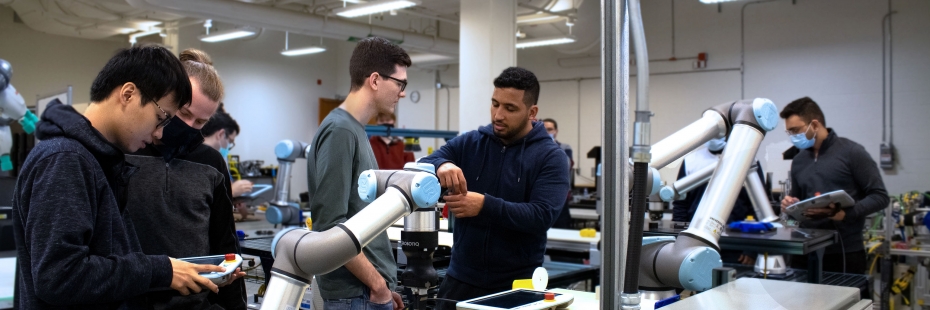SMSC 7102 - Siemens Mechatronic Systems Certification Program Level 1
Course Description

Students should complete the Siemens Mechatronic Systems Certification Program to prepare for the SMSCP certification exam managed by the Siemens Technik Akademie. The following are compulsory courses that are combined into this one non-credit course offering:
(Electro) Pneumatic and Hydraulic Control Circuits
Course Description
This course covers the basics of pneumatic, electro pneumatic and hydraulic control circuits in a complex mechatronic system. Students will learn the functions and properties of control elements based upon physical principles, and the roles they play within the system. Technical documentation such as data sheets, circuit diagrams, displacement step diagrams and function charts will also be covered. By understanding and performing measurements on the pneumatic and hydraulic control circuits, students will learn and apply troubleshooting strategies to identify, localize and (where possible) to correct malfunctions. Preventive maintenance of (electro) pneumatic and hydraulic components as well as safety issues within the system will be discussed.
Course Goals
Upon completion of the course, students should:
- Understand what a mechatronic system is, and the inter-relationships of components and modules within a complex mechatronic system with a focus on (electro) pneumatic and hydraulic control systems.
- Understand the role of (electro) pneumatic and hydraulic control systems in complex mechatronic system and subsystems.
- Understand troubleshooting, maintenance and safety issues revolving around (electro) pneumatic and hydraulic circuits within a mechatronic system.
Course Objectives
At the conclusion of this course, students will be able to:
- Explain the role of various (electro) pneumatic and hydraulic components within a given system or module.
- Trace and describe the flow of energy in a given mechatronic system or subsystem.
- Describe the basic physical properties of pneumatic and hydraulic components.
- Carry out measurements and adjustments on pneumatic and hydraulic components in a mechatronic system.
- Read, analyze and utilize the technical documents such as data sheets, circuit diagrams, displacement step diagrams, timing diagrams and function charts for the pneumatic and hydraulic components within a mechatronic system.
- Correctly localize, identify and document causes of malfunctions in pneumatic and hydraulic circuits, based upon the technical documentation.
- Correct malfunctions in pneumatic and hydraulic circuits, where possible, or correctly identify the expertise required to correct a malfunction.
- Apply safety rules while working on the system.
- Transfer the knowledge learned from one system to another system.
Digital Fundamentals and Programmable Logic Controllers
Course Description
This course covers the fundamentals of digital logic and an introduction to programmable logic controllers (PLCs) in a complex mechatronic system with a focus on the automation system SIMATIC S7-1200 and the appropriate programming software STEP7. Using computer simulation, students will learn the role PLCs play within a mechatronic system or subsystem. They will also learn basic elements of PLC functions by writing small programs and testing these programs on an actual system. Students will learn to identify malfunctioning PLCs, as well as to apply troubleshooting strategies to identify and localize problems caused by PLC hardware.
Course Goals
Upon completion of the course, students should:
- Understand the role of programmable logic controllers in complex mechatronic systems, modules and subsystems.
- Understand the flow of information in the system.
- Understand and apply troubleshooting, maintenance and safety rules.
Course Objectives
At the conclusion of this course, students will be able to:
- Explain the role of programmable logic controllers within a given system or module.
- Trace and describe the flow of information in a given mechatronic system or subsystem with a focus on the control function of PLCs in the system.
- Describe the basic functions of PLCs.
- Read, analyze and utilize the technical documents such as data sheets, timing diagrams, operation manuals, schematics.
- Correctly localize, identify and document system malfunctions in or caused by PLC hardware, based upon the technical documentation.
- Apply safety rules while working on the system.
- Transfer the knowledge learned from one system to another system.
Electrical Components
Course Description
This course covers the basics of electrical components in a complex mechatronic system. Based upon a physical system, students will learn the basic functions and physical properties of electrical components, and the roles they play within the system. Technical documentation such as data sheets, schematics, timing diagrams and system specifications will also be covered. By understanding the complete system, the flow of energy through it and measurements on the components, students will learn and apply troubleshooting strategies to identify, localize and (where possible) correct malfunctions. Preventive maintenance and safety issues for electrical components within the system will be discussed.
Course Goals
Upon completion of the course, students should:
- Understand what a mechatronic system is, and the inter-relationships of components and modules with a system.
- Understand the flow of energy, mass and information in the system.
- Understand the role of electrical components in complex mechatronic system and subsystems.
- Understand troubleshooting, maintenance and safety issues within a mechatronic system.
Course Objectives
At the conclusion of this course, students will be able to:
- Describe what comprises a mechatronic system or module.
- Explain the role of various electrical components within a given system or module.
- Trace and describe the flow of energy in a given mechatronic system or subsystem.
- Describe the basic physical properties of electrical components.
- Read, analyze and utilize the technical documents such as data sheets, timing diagrams, operation manuals, schematics, etc. for a mechatronic system.
- Carry out measurements on electrical components in a mechatronic system.
- Correctly localize, identify and document causes of malfunctions in electrical components, based upon the technical documentation.
- Where possible correct malfunctions, or correctly identify the expertise required to correct a malfunction.
- Apply safety rules while working on the system.
- Transfer the knowledge learned from one system to another system.
Course Content
Content to be covered within this course includes the following topics:
- Basic elements and quantities
- Circuit diagrams, data sheets, schematics
- Measurements
- Energy sources
- Relays and Contactors
- Input and Output Devices (Switches and Indicators)
- Solenoids
- Fuses and Circuit Breakers (Overcurrent protection)
- Reed Contacts
- Photoelectric Sensors
- Inductive Sensors
- Capacitive Sensors
- Safety issues, including local regulations
- Preventive and routine maintenance of components
- Troubleshooting of the electrical components within a module or system
Mechanical Components and Electrical Drives
Course Description
This course covers the basics of mechanical components and electrical drives in a complex mechatronic system. Based upon a physical system, students will learn the basic functions and physical properties of mechanical components as well as electrical drives (AC and DC), and the roles they play within the system. They will also learn about mechanical components which lead and support the energy through a mechanical system to increase efficiency and to reduce wear and tear. Materials, lubrication requirements and surface properties will be examined. Technical documentation such as data sheets and specifications of mechanical elements and electrical drives will also be covered. By understanding the interworkings of the complete system, students will learn and apply troubleshooting strategies to identify, localize and (where possible) to correct malfunctions. Preventive maintenance of mechanical elements and electrical drives as well as safety issues within the system will be discussed.
Course Goals
Upon completion of the course, students should:
- Understand the role of mechanical components and electrical drives in complex mechatronic systems, modules and subsystems.
- Understand the flow of energy in the system.
- Understand troubleshooting, preventive maintenance and safety issues revolving around mechanical components and electrical drives within a mechatronic system.
Course Objectives
At the conclusion of this course, students will be able to:
- Explain the role of various mechanical components within a given system or module.
- Trace and describe the flow of energy in a given mechatronic system or subsystem.
- Describe the basic physical properties of mechanical components including materials, lubrication requirements and surface properties.
- Carry out adjustments on mechanical components in a mechatronic system.
- Read, analyze and utilize the technical data sheets for the mechanical components and electrical drives within a mechatronic system.
- Correctly localize, identify and document causes of malfunctions in mechanical components or electrical drives, based upon the technical documentation.
- Correct malfunctions where possible, or correctly identify the expertise required to correct a malfunction.
- Apply safety rules while working on the system.
- Transfer the knowledge learned from one system to another system.
Notes
In addition to class time, open lab times will be available outside of class time. Details/times will be provided the first day of class.
Learners will be asked to adhere to the outlined health and safety requirements at the University of Windsor at the time the class is held. Health & Safety requirements will be provided one week before the start of the class.
Prerequisites
Minimum admission requirements include successful completion of secondary school diploma and English language proficiency. Verification may be requested.
